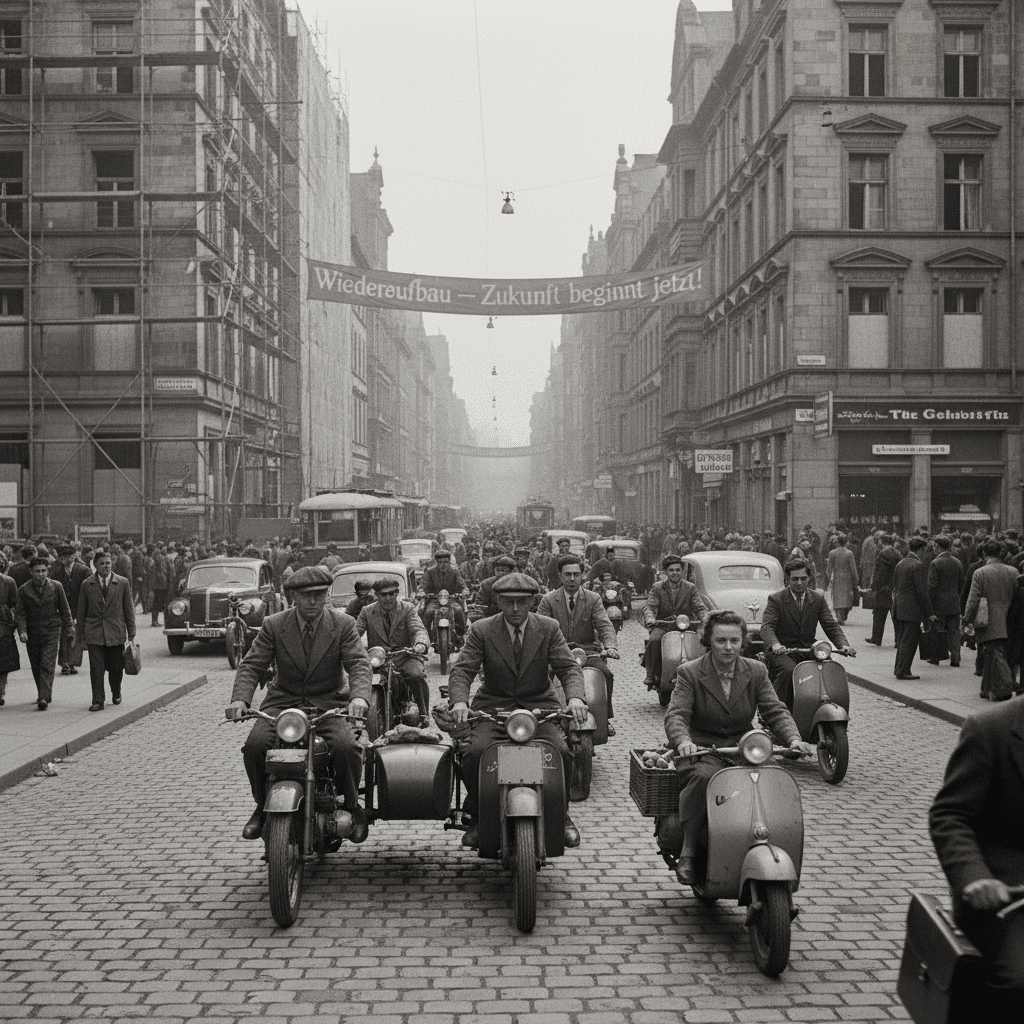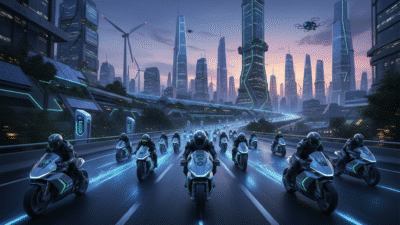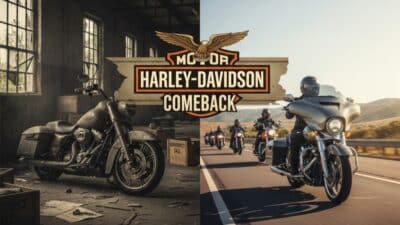The roar of an engine, the open road, the feeling of absolute freedom – for many, this is the essence of motorcycling. But the world of two wheels we know today wasn’t simply born. It was forged in the crucible of history, specifically the tumultuous aftermath of World War II. The conflict profoundly reshaped economies, societies, and personal aspirations, leading to a monumental transformation in how the motorcycle market changed after WWII. It wasn’t just about rebuilding; it was about reinventing. From humble, utilitarian transport to symbols of rebellion, sport, and cutting-edge engineering, the motorcycle’s journey after the war is a thrilling saga of innovation, cultural shifts, and sheer human ingenuity. Let’s rev up and explore this incredible evolution!
The Scars of War and the Hunger for Mobility
When the guns fell silent in 1945, Europe lay in ruins, and much of the world grappled with the immense human and economic cost. Yet, amidst the devastation, a powerful human need emerged: the need for mobility. Infrastructure was shattered, public transport was often non-existent, and families yearned to reconnect, rebuild, and return to a semblance of normalcy. This immediate and pressing demand for affordable, reliable transportation laid the groundwork for the motorcycle’s post-war resurgence.
Governments, industries, and individuals needed cost-effective solutions. Cars were often too expensive, too large, or simply unavailable. Factories that once produced tanks and planes now sought new products to build, and motorcycles, with their relatively simpler construction and lower material requirements, presented a compelling option. They were agile, fuel-efficient, and capable of navigating damaged roads, making them the perfect workhorses for a continent in recovery.
In the United States, returning servicemen, many of whom had ridden military motorcycles like the Harley-Davidson WLA or Indian 741B, harbored a newfound affinity for two-wheeled machines. They sought affordable personal transport and a sense of camaraderie, often recreating the bonds formed during wartime. This veteran influence was a significant driver of demand, creating a ready market for both new and repurposed bikes.
| Pros | Cons |
|---|---|
| – Affordable and accessible transport post-war | – Limited carrying capacity compared to cars |
| – Fuel-efficient in an era of resource scarcity | – Less protection from elements/accidents |
| – Easy to manufacture and repair with available resources | – Social stigma for certain groups (e.g., “bikers”) |
| – Fostered community and a sense of freedom | – Less stable than four-wheeled vehicles |
| – Ideal for navigating damaged or congested urban areas | – Can be challenging for long-distance travel |

From Utility to Leisure: The Shifting Purpose of the Motorcycle
Initially, the motorcycle was a pragmatic choice. Farmers used them, delivery services relied on them, and commuters found them invaluable. They were tools, designed for purpose rather than pleasure. However, as economies stabilized and societies began to heal, the motorcycle’s role started to evolve dramatically.
The late 1940s and 1950s saw an increase in disposable income and leisure time, particularly in Western countries. People began to seek recreation, and motorcycling offered an exhilarating escape. The image of the motorcycle began to transform from a mere utility vehicle to a symbol of adventure, personal expression, and even rebellion.
This shift gave rise to new market segments:
- Sport and Racing: Motorsport, which had been curtailed during the war, exploded in popularity. Races like the Isle of Man TT gained legendary status, pushing manufacturers to build faster, more agile machines. Enthusiasts flocked to tracks and competitive events, fueling demand for performance-oriented bikes.
- Touring and Leisure Riding: For those seeking less adrenaline, touring motorcycles offered comfort and reliability for longer journeys. Weekend rides became a popular pastime, fostering a sense of community among riders. This era also saw the nascent development of motorcycle clubs, cementing the social aspect of riding.
- Counter-Culture Icon: Perhaps one of the most enduring legacies of this period was the motorcycle’s adoption by various subcultures. Films like “The Wild One” (1953) starring Marlon Brando cemented the image of the leather-clad biker as an anti-establishment figure, a symbol of freedom and defiance. This cultural cachet, while sometimes controversial, significantly boosted the motorcycle’s appeal beyond its practical applications. It began to represent a lifestyle, not just a mode of transport.
Technological Leaps and Engineering Marvels
The experience of wartime manufacturing, with its focus on efficiency, ruggedness, and rapid innovation, spilled over into post-war motorcycle production. Engineers applied lessons learned from military vehicles to civilian bikes, leading to significant advancements.
- Improved Materials and Manufacturing Processes: War-driven research in metallurgy and mass production techniques made motorcycles more durable and cheaper to produce. Lighter alloys, more robust frames, and better suspension systems became common.
- Engine Development: Two-stroke engines, particularly popular in Europe for their simplicity and power-to-weight ratio, saw rapid development. Four-stroke engines also became more refined, offering greater reliability and torque. The pursuit of speed and efficiency was relentless. We can see how early advancements in internal combustion led to innovations like the first gasoline motorcycle and eventually influenced the evolution of automotive engineering as well, as discussed in Gottlieb Daimler and the First Gasoline Motorcycle.
- Specialization: As the market diversified, so too did motorcycle design. Off-road bikes, scramblers, café racers, and cruisers all began to emerge as distinct categories, each tailored to specific riding styles and preferences. This specialization was a direct response to the evolving demands of consumers, moving beyond a “one-size-fits-all” approach.
- Reliability and Maintenance: Manufacturers started focusing on bikes that were easier to maintain, crucial for widespread adoption. Innovations in lubrication systems, ignition, and braking made bikes more user-friendly. Understanding motorcycle maintenance, from checking coolant to chain care, became increasingly important for owners. Timely tips like those found in how to check and refill coolant on your motorcycle or tips for avoiding motorcycle chain sagging problems were gaining relevance for a growing population of riders.

The Rise of International Dominance: A Global Shake-Up
Before the war, British manufacturers like Triumph, BSA, and Norton dominated the global scene, known for their powerful, reliable machines. Post-WWII, this dominance faced severe challenges and new competition.
- British Resurgence (and eventual decline): British manufacturers initially capitalized on the post-war demand, quickly resuming production and even expanding into the lucrative American market. Their bikes, particularly parallel twins, became iconic. However, they struggled with innovation and adapting to changing consumer tastes in the long run. By the late 1960s, they began to lose ground.
- German Innovation (BMW and the boxer engine): Germany, despite its heavy war losses, saw BMW re-emerge as a strong player. Known for their distinctive boxer engines and shaft drive, BMW motorcycles offered a blend of reliability, comfort, and engineering prowess, carving out a niche for discerning riders.
- The Italian Flair (Vespas and Lambrettas): Italy, also devastated by war, revolutionized personal transport with the introduction of scooters like the Vespa and Lambretta. These nimble, stylish, and incredibly practical machines offered affordable, clean transport, appealing to a broader demographic, including women, and becoming cultural phenomena in their own right.
- Japanese Ascendancy (Honda’s Revolution): This was perhaps the most significant shift. Japan, emerging from the ashes of war, embraced motorcycle manufacturing with a fierce dedication to innovation, quality, and affordability. Companies like Honda, Suzuki, Yamaha, and Kawasaki started small, often mimicking Western designs, but quickly surpassed their mentors.
- Honda’s Masterstroke: Soichiro Honda’s philosophy of making motorcycles accessible to everyone led to the creation of lightweight, reliable, and user-friendly bikes like the Super Cub, introduced in 1958. Its success was unprecedented, proving that motorcycles weren’t just for enthusiasts or rebels but for the masses. Honda’s aggressive marketing campaign, “You meet the nicest people on a Honda,” brilliantly countered the negative “outlaw biker” stereotype prevalent in the US, opening the market to a much wider audience.
- Technological Prowess: Japanese manufacturers invested heavily in R&D, leading to multi-cylinder engines, electric starters, disc brakes, and superior electronics. Their relentless pursuit of performance and reliability, combined with mass-production efficiency, allowed them to offer better bikes at lower prices, fundamentally reshaping the global market.

Motorcycles as a Cultural Phenomenon: Beyond Transportation
As the motorcycle market matured, its cultural footprint deepened. It was no longer just about getting from A to B; it was about who you were and what you stood for.
- Symbols of Freedom and Individuality: The motorcycle became an ultimate symbol of personal freedom. The ability to hit the open road, explore, and be unconstrained by schedules or four walls resonated deeply with the post-war generation seeking self-expression.
- Community and Brotherhood: Motorcycle clubs, initially formed by veterans, grew exponentially. These clubs offered a sense of belonging, camaraderie, and shared passion. From organized touring groups to more informal gatherings, the social aspect of motorcycling became paramount. Events like rallies and runs cemented these bonds, creating a unique subculture.
- Fashion and Lifestyle: Riding a motorcycle influenced fashion, with leather jackets, boots, and specialized helmets becoming iconic. The “biker look” transcended actual riders, influencing mainstream fashion and popular culture. The motorcycle lifestyle was often portrayed in media, further romanticizing the image.
- Motorsport and National Pride: Motorcycle racing became a global spectacle, with national teams and riders achieving heroic status. The fierce competition between manufacturers, particularly in Grand Prix racing, pushed the boundaries of engineering and thrilled audiences worldwide. The development of racing machines like the Yamaha YZR-M1, renowned for its performance in MotoGP, shows a direct lineage from this post-war drive for speed and technological supremacy, as detailed in Yamaha YZR-M1: Rossi’s MotoGP Bike. This passion for racing continues to this day, with circuits like Mugello becoming legendary arenas for speed and skill, a story explored further in Exploring Mugello: Italy’s Racing Treasure.
Marketing and Distribution Revolution
The rapid expansion of the motorcycle market necessitated a complete overhaul of marketing and distribution strategies. Manufacturers couldn’t just build bikes; they had to sell dreams.
- Mass Marketing and Advertising: Early campaigns often focused on practicality and affordability. However, as the market diversified, advertising became more sophisticated, tapping into desires for freedom, adventure, and community. Japanese brands, especially Honda, famously used clever campaigns to broaden their appeal, moving beyond the traditional “tough guy” image.
- Dealership Networks: The growth of dedicated motorcycle dealerships was crucial. These weren’t just places to buy a bike; they were hubs for service, parts, and community gathering. Dealerships played a vital role in educating new riders, offering test rides, and building brand loyalty.
- Financing Options: As motorcycles became more expensive and aspirational, financing became available, making ownership accessible to a wider demographic. This further fueled demand and allowed consumers to purchase higher-end models.
- Global Reach: Post-war communication and transportation advancements allowed manufacturers to establish international supply chains and sales networks. This global approach was key to the Japanese brands’ success in penetrating markets worldwide.
Challenges and Adaptations: Competing with the Automobile
While the motorcycle market boomed, it wasn’t without its challenges. The primary competitor emerged in the form of the increasingly affordable and popular automobile.
- The Rise of the Car: By the late 1950s and 1960s, cars became more accessible to the average family, offering greater comfort, protection from the elements, and carrying capacity. For many, a car was the natural progression from a motorcycle as family needs grew.
- Safety Concerns: Motorcycles, by their very nature, offered less protection in an accident. As traffic increased, so did concerns about motorcycle safety, leading to early calls for improved rider training and protective gear.
- Environmental Regulations: Later in the century, as environmental awareness grew, motorcycles, like cars, faced increasing regulations regarding emissions and noise, prompting manufacturers to invest in cleaner and quieter technologies.
Despite these challenges, the motorcycle market proved resilient, adapting by further specializing and cementing its niche as a lifestyle choice. Manufacturers continued to innovate, focusing on specific segments like high-performance sportbikes, luxurious touring machines, or classic-styled cruisers, ensuring a place for two wheels in an increasingly four-wheeled world. This adaptability mirrors the broader history of transportation, where various vehicle types evolve and find their specific roles, much like the changing landscape of car design from the early 1900s to modern marvels, a journey highlighted in The Evolution of Car Design: From 1900 to 2025.

The Enduring Legacy: How WWII Still Shapes Our Ride Today
The period immediately following World War II was a crucible that fundamentally reshaped the motorcycle industry forever. The hunger for mobility, the innovative spirit of rebuilding nations, the rise of powerful new manufacturing giants, and the cultural transformation from utility to lifestyle symbol all contributed to the rich tapestry of the modern motorcycle world.
Today’s motorcycles, from the most advanced superbikes to the most rugged adventure tourers, bear the genetic imprint of this transformative era. The focus on reliability, performance, and rider experience, coupled with a deep appreciation for the community and freedom that motorcycling offers, all trace their roots back to those post-war years. When you feel the wind in your face and the thrum of the engine, remember the incredible journey that started when the world began to heal, and a new era of two-wheeled adventure began. It’s a legacy of passion, engineering, and the undeniable human spirit of getting out there and riding.
Frequently Asked Questions
What was the immediate demand for motorcycles after WWII?
After WWII, there was an immense demand for affordable and reliable transportation due to shattered infrastructure and economic hardship. Motorcycles offered a cost-effective, fuel-efficient, and agile solution for personal mobility and rebuilding efforts.
How did the perception of motorcycles change after the war?
Initially seen as utilitarian transport, motorcycles gradually evolved into symbols of leisure, sport, freedom, and even rebellion. This shift was fueled by increased disposable income, the rise of motorsport, and their adoption by various subcultures, making them cultural icons.
Which countries emerged as dominant players in the post-war motorcycle market?
While British manufacturers initially resumed dominance, German brands like BMW maintained a strong presence. However, the most significant shift was the ascendancy of Japanese manufacturers like Honda, Suzuki, Yamaha, and Kawasaki, who revolutionized the market with their focus on quality, innovation, and affordability.
What technological advancements were made in motorcycles after WWII?
Post-war motorcycles benefited from improved materials, more robust engine development (both two-stroke and four-stroke), and greater specialization in design. Lessons from wartime manufacturing led to more durable, reliable, and performance-oriented machines with innovations like electric starters and disc brakes appearing later.
How did motorcycles compete with the growing popularity of cars?
As cars became more affordable, motorcycles adapted by further specializing. They focused on niche markets like high-performance sportbikes, luxurious touring models, and classic cruisers, cementing their role as a lifestyle choice and a symbol of freedom rather than just primary transportation.
What role did returning soldiers play in the post-war motorcycle market?
Many returning servicemen, having used military motorcycles during the war, had a newfound appreciation for two-wheeled machines. They sought affordable personal transport and a sense of camaraderie, contributing significantly to the initial demand and the formation of early motorcycle clubs.
How did marketing and distribution change in the post-war era?
Marketing evolved from focusing on practicality to emphasizing freedom and adventure. Dedicated dealership networks grew, providing sales and service. Financing options became available, and manufacturers, particularly Japanese brands, adopted global distribution strategies to reach wider audiences.



